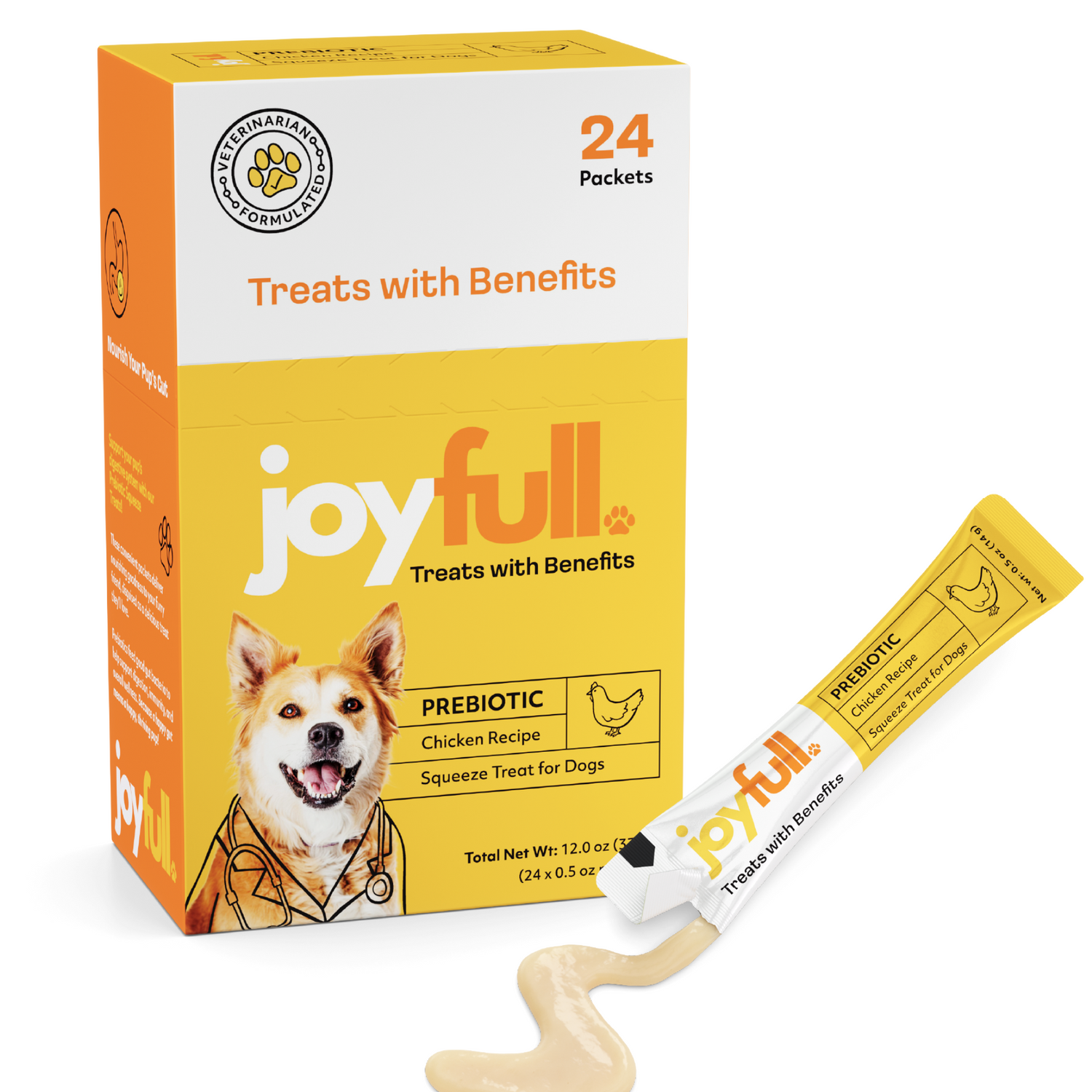
Best Cat Food for Weight Loss Guide
Let's be honest, a chubby cat is undeniably cute. But that extra "fluff" we find so endearing is one of the biggest health threats your cat can face. Choosing the right food isn't just about helping them lose a few pounds; it's a powerful way to head off serious diseases and give them a happier, more active life. A smart dietary change is the single most important first step you can take.
Why a Few Extra Pounds Are a Big Deal for Your Cat
It's so easy to dismiss a little extra weight on our cats. We see it as harmless padding, not a genuine health issue. But that seemingly small amount of weight puts a massive strain on their little bodies, opening the door to a whole list of painful and expensive medical problems.
Here's a little perspective: for a 10-pound cat, gaining just two pounds is the human equivalent of a 150-pound person gaining 30 pounds. Suddenly, it doesn't seem so minor, does it?
That extra weight isn't just dead weight, either. Fat is a biologically active tissue that constantly pumps out inflammatory signals throughout your cat's body. Over time, this chronic, low-grade inflammation can silently wreak havoc, damaging joints, stressing vital organs, and throwing their metabolism out of whack.
The Hidden Dangers of an Overweight Cat
When a cat is carrying too much weight, their risk for several debilitating conditions skyrockets. Recognizing these links helps drive home just how critical weight management is.
- Diabetes Mellitus: Overweight cats are up to four times more likely to develop diabetes. The excess fat makes their cells resistant to insulin, preventing them from properly regulating their blood sugar.
- Arthritis and Joint Pain: Imagine carrying a heavy backpack 24/7. That's what excess weight does to your cat's joints, leading to painful arthritis. This can make it hard for them to jump onto their favorite spot on the couch, play, or even get into the litter box without pain.
- Reduced Quality of Life: Beyond the major diseases, obesity often makes cats lethargic and less interested in playing or interacting. It quietly steals the playful, joyful spirit that makes them who they are.
The rise of specially formulated weight-management foods isn't a fad. It's a direct response to a global pet health crisis. Experts estimate that 25% to 35% of domestic cats in developed countries are now overweight or obese. You can dive deeper into this trend with insights from Business Insider.
How Weight Loss Cat Food Actually Works
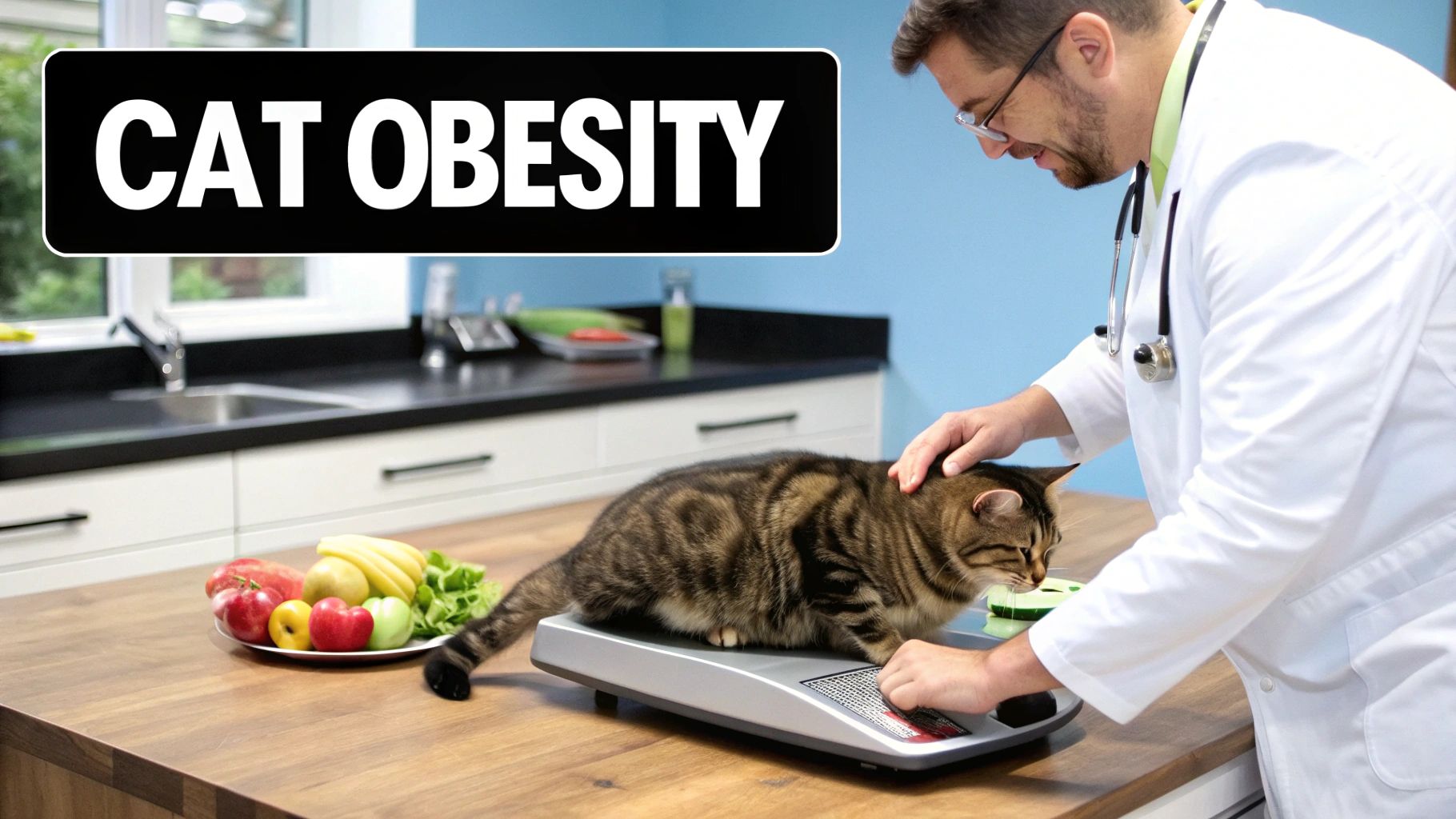
So, what’s the secret behind a good "diet" cat food? It’s not some magical formula, but a careful nutritional strategy designed to do one thing really well: help your cat burn fat while holding onto their precious muscle. Think of it as a smart, targeted plan for a tiny athlete.
At its core, any effective weight loss plan for your cat operates on a simple principle: creating a safe calorie deficit. This just means they take in fewer calories than they burn each day, forcing their body to dip into fat reserves for energy.
But here's the critical part: you can't just feed them less of their regular food. That’s a recipe for nutritional deficiencies and a very hungry, unhappy cat. The type of calories they get is what really matters. A properly designed food ensures the whole process is healthy, sustainable, and doesn't leave your cat feeling constantly starved.
Let's break down the three key pillars that make these diets so effective.
High Protein to Protect Muscle
For cats, who are natural carnivores, protein isn't just a nutrient—it's everything. When a cat is in a calorie deficit, their body can start breaking down muscle for energy. That's the last thing we want. A diet rich in high-quality protein acts as a shield, protecting that essential muscle mass.
Why is this so important? Lean muscle is metabolically active, meaning it burns more calories than fat, even when your cat is just napping. By preserving muscle, you keep their metabolism humming along, which actually helps speed up fat loss.
The Bottom Line: A high-protein diet makes sure your cat loses the right kind of weight—fat—while keeping the muscle that powers their metabolism and keeps them strong.
On top of that, protein is fantastic for satiety. It helps your cat feel fuller for much longer than fats or carbs do. This simple fact can be a lifesaver, cutting down on the constant begging and making the diet a whole lot easier for everyone involved. For a closer look at this, check out our guide to cat food with high protein.
Lower Fat for Fewer Calories
To achieve that all-important calorie deficit, weight management foods have to be less energy-dense. The easiest way to do that is by carefully managing the fat content. Fat is incredibly calorie-dense, packing more than double the calories per gram compared to protein or carbs.
Now, "low fat" doesn't mean "no fat." Healthy fats are still crucial. Your cat needs essential fatty acids like omega-3s and omega-6s for everything from a healthy coat and skin to proper brain function. A quality diet food provides these necessary fats, just in moderation, to keep the overall calorie count in check.
This clever balancing act allows you to feed a portion that actually looks and feels like a real meal, filling up the bowl without overloading your cat on calories.
High Fiber to Keep Hunger at Bay
Fiber is the unsung hero of any successful feline diet. While it provides almost no calories, it’s a powerhouse when it comes to keeping your cat feeling full and satisfied. This feeling of fullness is what we call satiety.
Certain fibers work by absorbing water in the stomach and intestines, swelling up to create a sense of fullness that lasts for hours. There are two main types you'll see in diet foods:
- Soluble Fiber: Dissolves in water to form a gel-like substance. This slows digestion way down, helping your cat feel satisfied long after they've left their bowl.
- Insoluble Fiber: This is "bulk." It doesn't dissolve but passes through the digestive system, promoting regular, healthy bowel movements.
A smart blend of these fibers is the key to managing your cat's hunger. It helps prevent the sad meows and persistent ankle-rubbing that can so easily derail a weight loss plan. Together, this trio of high protein, controlled calories, and high fiber creates a complete system for safe, effective, and sustainable weight loss.
How to Read the Label on Weight Loss Cat Food
Trying to pick the right weight loss food for your cat can feel overwhelming, but it really boils down to one crucial skill: learning to read the label. Don't get distracted by the fancy claims and cute pictures on the front of the bag. The truth is always on the back, in the ingredient list and the guaranteed analysis panel.
Think of the ingredient list like a recipe, with the ingredients listed by weight. For any good weight loss food, you want to see a named animal protein—like 'deboned chicken' or 'salmon'—right at the top. This is your first and best clue that you're looking at a high-quality food that will help your cat maintain lean muscle while they shed fat. Vague terms like 'meat by-products' are a bit of a red flag; they shouldn't be the star of the show.
Look for Functional Ingredients
Beyond just protein, today’s best weight loss formulas are packed with what we call functional ingredients. These aren't just filler; they serve a specific, helpful purpose in your cat's weight management journey.
A real superstar here is L-carnitine. I like to think of L-carnitine as a tiny shuttle bus inside your cat's body. Its main job is to grab fat molecules and drive them straight to the cellular power plants (the mitochondria) to be burned for energy. This makes their body much better at tapping into its own fat reserves, which is exactly what we want.
You'll also find that many top-tier foods add beneficial fibers and ingredients for gut health. Things like powdered cellulose boost the fiber content, which is fantastic for helping your cat feel full and satisfied on fewer calories. Prebiotics are another great addition, as they help support a healthy digestive system, which is always important during a diet change.
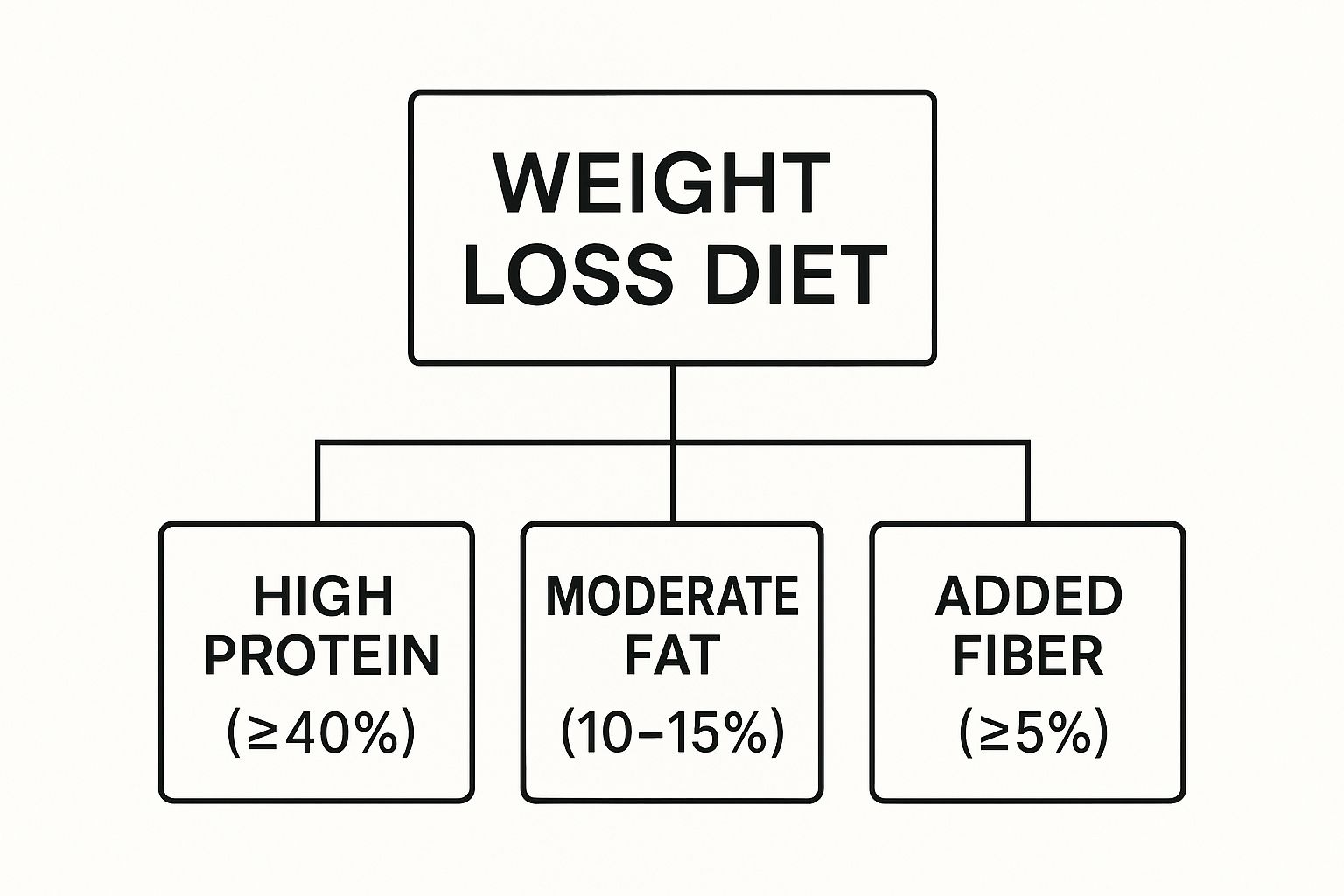
As this shows, it all starts with that high-protein base. From there, you want a controlled amount of fat and plenty of fiber to keep things moving and ensure your cat feels full between meals.
Let's break down some of the most important ingredients you'll see on the label.
Key Ingredients in Weight Loss Cat Food
The table below highlights the key players to look for in a quality weight loss formula and explains the role each one plays.
| Ingredient Type | Examples | Primary Function in Weight Loss |
|---|---|---|
| High-Quality Animal Protein | Deboned Chicken, Turkey, Salmon, Lamb | Preserves Lean Muscle Mass. Cats burn fat, not muscle, when their protein intake is high, which is critical for a healthy metabolism. |
| Beneficial Fiber | Powdered Cellulose, Beet Pulp, Psyllium Husk | Promotes Satiety. Fiber helps your cat feel fuller for longer, reducing begging and overeating. It also supports digestive health. |
| Functional Supplements | L-Carnitine | Aids in Fat Metabolism. This amino acid helps transport fatty acids into cells to be converted into energy, making fat burning more efficient. |
| Essential Fatty Acids | Fish Oil (Omega-3s), Flaxseed, Chicken Fat | Supports Skin, Coat, and Joint Health. Healthy fats are still crucial, even in a diet. They reduce inflammation and provide energy. |
| Antioxidants | Vitamin E, Vitamin C, Blueberries, Cranberries | Supports Overall Immune Health. Weight loss can be stressful on the body, so antioxidants help protect cells from damage and support a strong immune system. |
Looking for this combination of ingredients will put you on the right track to finding a food that supports healthy, sustainable weight loss, not just calorie cutting.
Decode the Guaranteed Analysis
If the ingredient list is the recipe, the guaranteed analysis is the nutrition facts label. This little box tells you the minimum percentages of protein and fat, and the maximum amounts of fiber and moisture. It’s your cheat sheet.
Pro Tip: Comparing wet and dry food can be tricky because of the huge difference in moisture content. To get a true apples-to-apples comparison, you have to calculate the nutrients on a "dry matter basis." This simple calculation removes the water from the equation so you can see the real nutrient levels.
For a weight loss diet, here are the numbers you're generally looking for:
- Crude Protein: You want this to be high—at least 40% on a dry matter basis. Protein protects that precious muscle.
- Crude Fat: Look for a moderate level, usually somewhere between 10-15%. This provides necessary fatty acids without piling on the calories.
- Crude Fiber: More is better here. A fiber content of 5% or more is great for helping your cat feel full.
Getting comfortable with reading the label is the single most powerful tool you have in this process. For a more detailed look at making smart food choices, check out our complete guide on how to choose cat food.
Choosing Between Wet and Dry Food for Weight Loss
https://www.youtube.com/embed/35HBfh4PNXU
The classic debate of wet versus dry food gets a lot more interesting when your cat needs to lose a few pounds. Both have their pros and cons, and the best choice really boils down to your cat's specific needs, your budget, and what you can realistically stick with long-term.
When it comes to weight management, wet food usually gets the nod for one huge reason: hydration. Its moisture content is often over 75%, which is fantastic for keeping your cat properly hydrated. All that water also adds volume, which helps your cat feel physically full while taking in fewer calories.
It's a bit like us choosing between a big bowl of soup and a small handful of crackers. The soup fills you up more because of all the liquid, even if the crackers technically have more calories packed into them. This feeling of fullness can be a lifesaver when you have a cat who seems to be constantly begging for more.
The Case for Wet Food
The benefits of wet food go beyond just water content. It's also typically higher in protein and lower in carbohydrates than most dry kibble, which is much closer to what a cat would naturally eat in the wild. This high-protein, low-carb profile helps maintain lean muscle while cutting back on the carbs that can easily turn into fat.
This powerful combination makes wet food a fantastic choice for managing not just weight, but other health issues too.
- Promotes Fullness: All that moisture helps your cat feel satisfied, making them less likely to overeat or beg between meals.
- Supports Urinary Health: Better hydration is key for flushing the urinary tract and helping prevent painful crystals or blockages, a common concern for less active indoor cats.
- Better for Diabetic Cats: Because most wet foods are naturally low in carbohydrates, they can help keep blood sugar levels stable—a critical factor for diabetic and pre-diabetic cats.
The Practicality of Dry Food
While wet food has some clear advantages, let’s be realistic—dry food has its place. Kibble is undeniably more convenient and budget-friendly, which is a major plus for busy families. You can also leave it out for a while without it spoiling, which works well for cats who are grazers.
Many of today’s weight-management kibbles are specially formulated with high fiber to help cats feel full and use quality protein sources to support muscle. They might not have the same hydrating power as wet food, but they can still be a perfectly effective tool in a weight loss plan.
A "mixed feeding" plan can give you the best of both worlds. You could serve a small meal of wet food once or twice a day for that hydration and protein boost, while leaving a carefully measured amount of weight-loss kibble in a puzzle feeder. This provides a little mental stimulation and lets your cat graze without sabotaging their diet.
At the end of the day, there isn't a single "winner" in the wet vs. dry debate. The best food is the one that addresses your cat's health needs and that you can feed consistently. Whether you go with wet, dry, or a combination of both, sticking to the right portion size is the real secret to success.
Creating a Feeding Plan That Actually Works
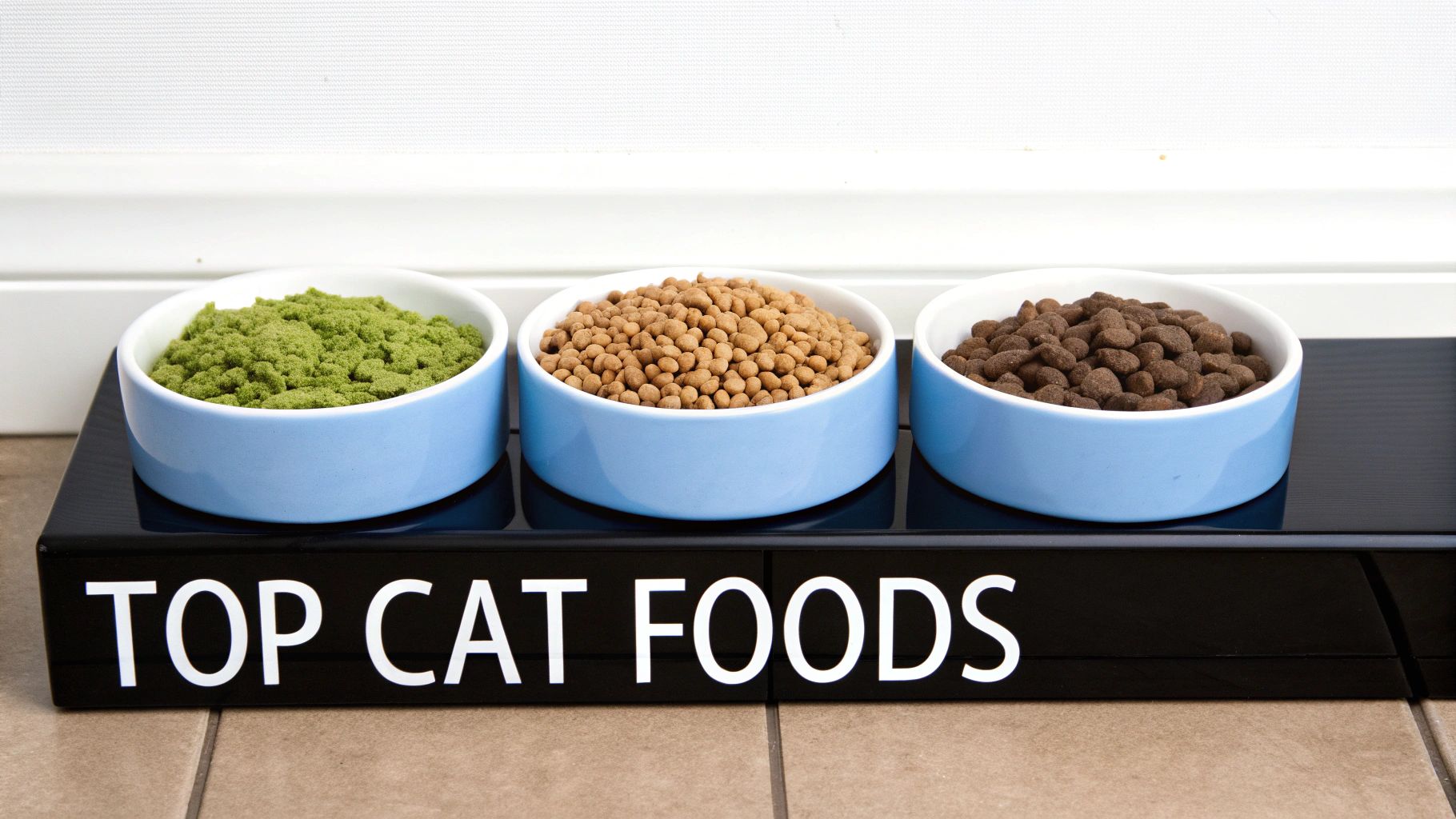
Picking out the best cat food for weight loss is a great first step, but it's really only half the battle. Even the most perfectly balanced diet won't do a thing if the feeding plan itself isn't right. Now, let's shift from the what they eat to how they eat, building a practical plan that turns that carefully chosen food into real, noticeable results.
The biggest hurdle for most cat owners is the habit of free-feeding, which is just leaving a full bowl of food out all day. It’s convenient for us, but it makes it totally impossible to control how many calories your cat is actually eating. For a cat on a diet, it’s like trying to stick to a budget with an open wallet—it just doesn't work.
This is where scheduled meals become a game-changer. By feeding your cat specific portions just two or three times a day, you regain control. This simple switch helps regulate their metabolism, manages their hunger, and lets you be precise about their calorie intake. You're transforming mealtime from an all-day buffet into a healthy, predictable routine.
Figuring Out Your Cat's Daily Portion Size
So, how much should you feed them? This isn't something you want to guess. It takes a little bit of simple math and, most importantly, a conversation with your veterinarian. Think of them as your essential partner in this whole process.
Your vet will figure out your cat’s ideal weight and calculate their specific daily calorie needs to lose weight safely. This number, often called their Resting Energy Requirement (RER), is the foundation of your entire plan.
A Critical Warning: Never, ever drastically slash your cat's food intake without talking to your vet first. Rapid weight loss can trigger a dangerous, life-threatening liver condition called hepatic lipidosis. The goal is slow and steady, aiming for a safe weight loss of 1-2% of their body weight each week.
Smart Tools for a Smooth Transition
Once you have that daily calorie number, it's time to put the plan into action.
- Get a Kitchen Scale: Measuring cups can be surprisingly inaccurate. A digital kitchen scale is your best friend here, ensuring you’re feeding the exact same portion every single time. No more guesswork.
- Try Puzzle Feeders: These brilliant toys make your cat work a bit for their food. It slows them down and provides some much-needed mental stimulation. A meal that used to be gone in five seconds can now become a fun 15-minute activity, which really helps them feel more satisfied.
- Switch Foods Slowly: When you introduce a new weight-loss food, do it gradually over a 7-10 day period. Start by mixing just a little of the new food in with the old, and slowly increase the ratio. This gives their digestive system time to adjust and prevents an upset stomach.
And what about treats? The good news is you don’t have to cut them out completely. You just have to be smart about them and make sure they’re factored into that daily calorie budget. You can get some great ideas by reading our guide on what makes good cat treats and how to give them responsibly.
Ultimately, a winning strategy combines the right food with a structured feeding plan. The best weight loss formulas are typically high in protein (around 59.8%), have moderate fat (15.7%), and are high in fiber (11.3%) to help your cat feel full while preserving muscle. When you pair that powerful nutrition with controlled portions, you're creating a sustainable path to a healthier, happier cat.
Lifestyle Changes That Support Your Cat's Diet
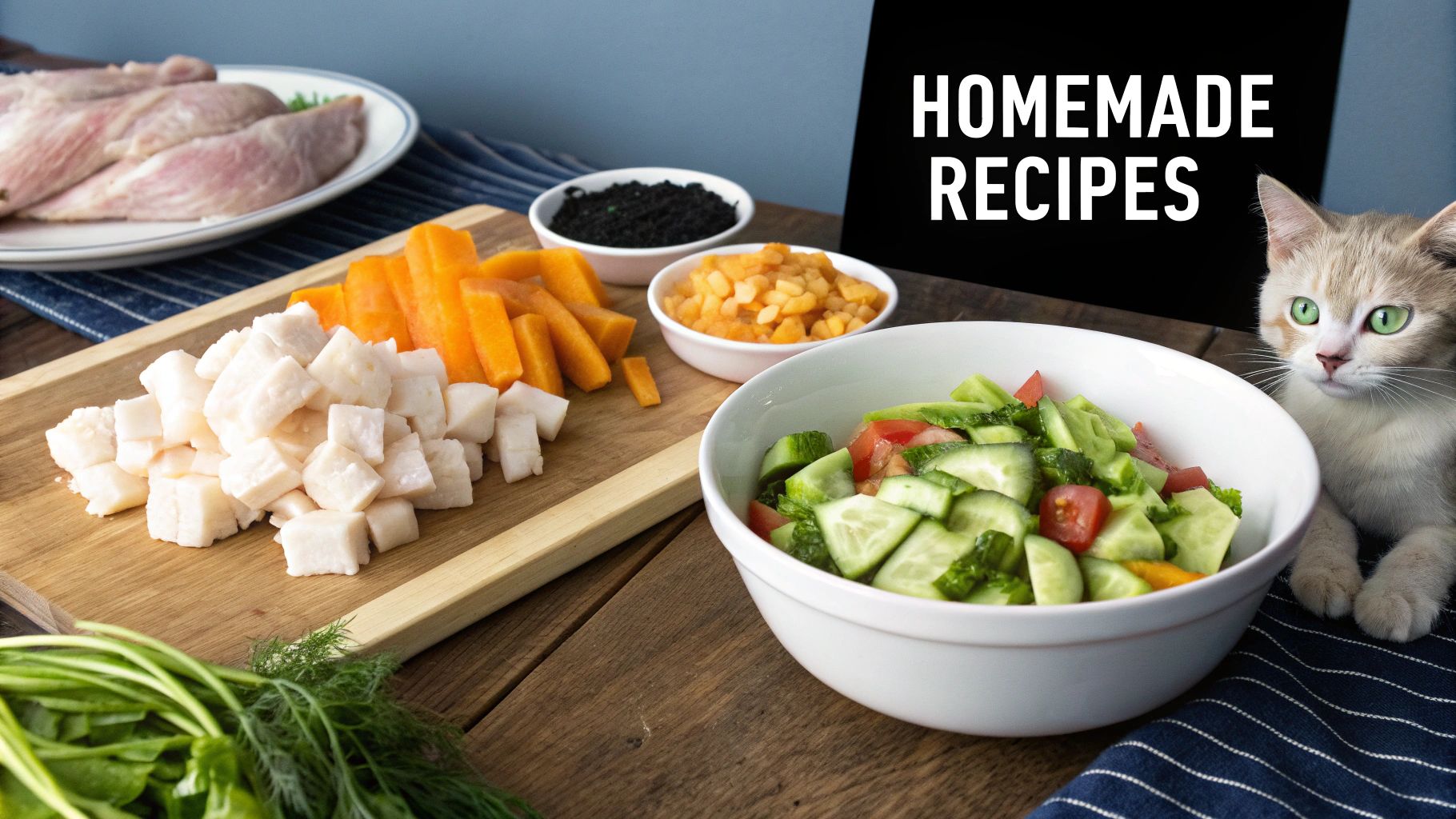
Picking the right food is a fantastic start, but a cat's weight loss journey doesn't end at the food bowl. Think of it this way: diet and lifestyle are two sides of the same coin. For real, lasting success, you have to address both. Supporting your cat's new eating plan with more activity and a stimulating environment is what makes the difference.
This well-rounded approach is becoming more common as we increasingly see our pets as part of the family. It’s actually a major factor driving the global cat food market, which is expected to hit USD 33.1 billion by 2029. This growth shows just how much we're focusing on our cats' overall wellness, especially when it comes to tackling issues like obesity. You can dig deeper into these trends in the cat food market to see the bigger picture.
Sparking Your Cat's Inner Hunter
Deep down, every cat is a natural athlete. The problem is, a cozy indoor life doesn't give them much to do. Your job is to reawaken that instinct to hunt, pounce, and play. This not only burns calories but also keeps their minds sharp and engaged.
-
Interactive Play: Set aside at least two 10-15 minute sessions a day for some focused playtime. Feather wands, laser pointers (just be careful never to shine it in their eyes!), and crinkly toy mice are perfect for getting them running and jumping.
-
Go Vertical: Cats are born climbers. A tall cat tree or some sturdy wall shelves can transform your living space into a feline jungle gym, giving them a place to stretch, climb, and survey their kingdom.
The goal here isn't to run them ragged. It's all about engagement. Cats in the wild hunt in short, intense bursts, so mimicking that pattern with frequent, quick play sessions is far more effective than trying to get them to run a marathon.
Managing Treats Without Derailing Progress
Let's be honest, treats are a big part of how we bond with our cats. You don't have to give them up completely, but you do need to be smarter about them. A good rule of thumb is that treats should account for no more than 10% of their total daily calories.
First, swap out the high-calorie snacks for healthier options. Look for low-calorie commercial treats, or offer up small pieces of plain cooked chicken or single-ingredient freeze-dried meats.
Next, make them work for it! Instead of just handing over a treat, toss it across the room and let them chase it down. It’s a simple trick that turns snack time into a mini-workout, reinforcing all the other great work you're doing.
Got Questions About Your Cat's Diet? Let's Talk.
Embarking on a weight loss plan with your cat can feel a little overwhelming. You've got the food, you've got the plan, but you've also got questions. That's completely normal. Getting clear, practical answers is the best way to feel confident and ensure you're helping your cat in the safest way possible.
Let's dive into some of the most frequent concerns I hear from cat owners.
How Fast Is Too Fast for Weight Loss?
This is a big one, and the answer is simple: slow and steady wins the race. You're aiming for a gradual, safe weight loss of about 1-2% of their total body weight per week. It might not sound like much, but it's the healthy way to do it.
Shedding pounds any faster can put your cat at risk for a very serious liver condition called hepatic lipidosis (often called fatty liver disease). Think of it as a marathon, not a sprint. The best approach is always to work with your vet to map out a safe timeline and track your cat’s progress together.
My Cat Seems Starving All the Time! What Can I Do?
Ah, the eternally hungry cat on a diet—a classic dilemma. If your cat is constantly begging for more, it's a sign we need to adjust the strategy, not just ignore them.
First, take another look at the food's ingredient list. A good weight-management food should be high in both protein and fiber. These are the powerhouse nutrients that help your cat feel full and satisfied for longer.
Next, let's change how you feed them. Instead of one or two big meals, divide that same daily portion into several smaller ones. You could also introduce a puzzle feeder. These clever toys make your cat work a bit for their kibble, which slows down eating, engages their brain, and makes a small meal feel much more substantial.
A quick word of caution: It's tempting to just feed less of your cat's current food, but this can backfire. When you slash the portion size of a regular cat food, you're also cutting back on essential vitamins and minerals. This can lead to nutritional gaps. A true weight loss formula is specially designed to be lower in calories while still being jam-packed with all the nutrients your cat needs to stay healthy and vibrant.
Here at Joyfull, we're all about creating food that fuels your pet's well-being. Our recipes are built on clean ingredients and top-notch proteins, perfect for helping your cat get to a healthy weight the right way. See what we have to offer at https://joyfullpet.com.
